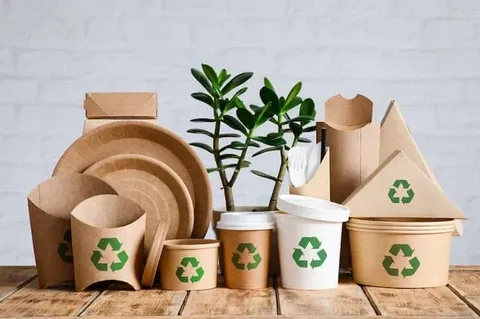The packaging industry is undergoing a profound transformation. No longer are consumers and businesses content with single-use plastics destined for landfills. Instead, the demand for sustainable packaging solutions is exploding, driven by environmental consciousness, stricter regulations, and a growing awareness of the circular economy. As we look towards 2025, several groundbreaking innovations are poised to reshape the market, offering viable alternatives that minimize waste, reduce environmental impact, and even add value to products. Let’s dive into the top sustainable packaging innovations that are leading the charge nowadays.
The Urgency of Sustainable Packaging
Before exploring the innovations, it’s crucial to understand the urgency driving this shift. The current packaging landscape is unsustainable:
- Environmental Pollution: Plastic pollution is choking our oceans, harming wildlife, and contaminating ecosystems.
- Resource Depletion: Traditional packaging relies heavily on finite resources like fossil fuels and virgin forests.
- Consumer Demand: Consumers are increasingly choosing brands that demonstrate a commitment to sustainability.
- Regulatory Pressure: Governments worldwide are implementing stricter regulations on packaging waste and promoting the use of eco-friendly alternatives.
These factors are converging to create a powerful imperative for change, pushing companies to embrace sustainable packaging solutions.
Top Sustainable Packaging Innovations to Watch in 2025
Here’s a look at the most promising innovations poised to dominate the sustainable packaging landscape by 2025:
- Plant-Based and Biodegradable Plastics:
This is arguably the most significant area of innovation. Plant-based plastics, derived from renewable sources like corn starch, sugarcane, and cassava, offer a compelling alternative to traditional petroleum-based plastics.
- PLA (Polylactic Acid): A compostable polymer derived from corn starch or sugarcane, ideal for food packaging, cups, and cutlery. While it requires specific composting conditions to break down effectively, advancements are making it more readily compostable.
- PHA (Polyhydroxyalkanoates): Another biodegradable plastic produced by microorganisms. PHAs are more versatile than PLAs and can degrade in a wider range of environments, including marine environments.
- Cellulose-Based Packaging: Utilizing cellulose from sources like wood pulp, agricultural waste, and even algae, this offers a strong and versatile material for various packaging applications. Nanocellulose, in particular, exhibits exceptional strength and barrier properties.
- Mushroom Packaging (Mycelium):
Mycelium, the root structure of mushrooms, is revolutionizing protective packaging.
- How it Works: Mycelium is grown around agricultural waste (like hemp or straw) in a mold, creating a custom-shaped, biodegradable packaging material.
- Benefits: It’s strong, lightweight, compostable, and requires minimal energy to produce.
- Applications: Ideal for protecting fragile items like electronics, furniture, and even wine bottles.
- Seaweed Packaging:
Seaweed is an abundant and renewable resource with incredible potential for packaging.
- Edible Packaging: Some companies are developing edible seaweed packaging for food and beverages, eliminating waste entirely.
- Biodegradable Films: Seaweed can be processed into biodegradable films and coatings for various applications, from food wrappers to sachets.
- Benefits: Seaweed is fast-growing, requires no land or freshwater, and absorbs carbon dioxide during its growth cycle.
- Recycled and PCR (Post-Consumer Recycled) Materials:
Increasing the use of recycled content is a cornerstone of sustainable packaging.
- PCR Plastics: Utilizing plastics recycled from consumer waste reduces the demand for virgin plastic and lowers the carbon footprint of packaging.
- Recycled Paper and Cardboard: Utilizing recycled paper fibers in packaging significantly reduces deforestation and conserves water and energy.
- Challenges: Ensuring the quality and safety of recycled materials is crucial, as is improving recycling infrastructure to increase the availability of these materials.
- Water-Soluble Films:
These innovative films dissolve completely in water, making them ideal for single-dose applications.
- Applications: Laundry detergents, cleaning products, and even some food products can be packaged in water-soluble films.
- Benefits: Eliminates packaging waste entirely and simplifies disposal for consumers.
- Considerations: Careful consideration must be given to the product being packaged to ensure compatibility and prevent premature dissolution.
- Edible Films and Coatings:
Extending shelf life while reducing packaging waste is the goal of edible films and coatings.
- Natural Sources: These films are often derived from natural sources like fruits, vegetables, and seaweed.
- Applications: Coatings for fruits and vegetables to prevent spoilage, films for wrapping candies or snacks, and capsules for supplements.
- Benefits: Reduces the need for traditional packaging and can even add nutritional value to the product.
- Smart and Active Packaging:
These technologies enhance food safety, extend shelf life, and reduce food waste.
- Oxygen Absorbers: Remove oxygen from packaging to prevent spoilage.
- Moisture Regulators: Control humidity levels to maintain product freshness.
- Time-Temperature Indicators: Monitor product temperature and indicate when it is no longer safe to consume.
- Benefits: Reduces food waste and improves consumer safety, indirectly contributing to sustainability.
- Reusable and Refillable Packaging Systems:
Moving away from single-use packaging altogether is the ultimate goal.
- Refill Programs: Consumers can refill containers at designated locations or through subscription services.
- Reusable Containers: Durable containers designed for multiple uses, often with deposit-refund systems.
- Benefits: Significantly reduces packaging waste and promotes a circular economy.
- Challenges: Requires significant infrastructure investment and consumer participation.
- Optimized Packaging Design:
Sometimes, the simplest solution is the most effective.
- Minimizing Material Use: Reducing the amount of packaging material required without compromising product protection.
- Optimizing Size and Shape: Designing packaging that is perfectly tailored to the product, reducing empty space and transportation costs.
- Sustainable Printing Inks: Using plant-based or water-based inks that are less harmful to the environment.
- Compostable Labels and Adhesives:
Even seemingly small details like labels and adhesives can impact the overall sustainability of packaging.
- Compostable Labels: Made from biodegradable materials and designed to break down during composting.
- Compostable Adhesives: Derived from natural sources and compatible with composting processes.
- Benefits: Ensures that the entire packaging unit is truly compostable, preventing contamination of the composting process.
The Road Ahead: Challenges and Opportunities
While these innovations offer tremendous promise, several challenges remain:
- Cost: Sustainable packaging solutions can sometimes be more expensive than traditional options.
- Performance: Ensuring that sustainable packaging materials meet the required performance standards for product protection and shelf life.
- Infrastructure: Developing adequate recycling and composting infrastructure to support the widespread adoption of sustainable packaging.
- Consumer Education: Educating consumers about proper disposal methods for different types of sustainable packaging.
Despite these challenges, opportunities are immense. By embracing innovation, investing in infrastructure, and educating consumers, we can create a truly sustainable packaging ecosystem that benefits both businesses and the world. The shift towards sustainable packaging solutions is not just a trend; it’s a fundamental transformation that will shape the future of the packaging industry and create a more sustainable world.
Conclusion
The future of packaging is undoubtedly green. The innovations discussed above represent a significant leap towards a more sustainable and circular economy. As businesses gear up for 2025 and beyond, embracing these sustainable packaging solutions is not just an ethical imperative but a strategic advantage. Companies that prioritize sustainability will not only reduce their environmental impact but also enhance their brand image, attract environmentally conscious consumers, and stay ahead of evolving regulations.
Acumen Packaging understand the complexities and opportunities within the sustainable packaging landscape. We encourage businesses to invest in packaging consultancy to navigate this evolving market effectively. Our expert guidance helps businesses identify the most suitable and cost-effective sustainable packaging options, optimize their packaging design, and implement strategies that align with their brand values and business goals. Investing in sustainable packaging is investing in a better future for your brand and the planet, driving both sales and creating lasting brand value.



